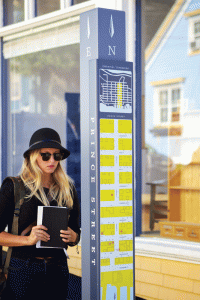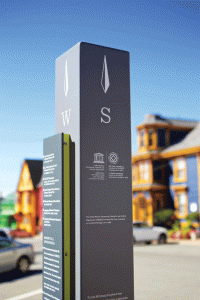
For each project, it is important to consider who will be reading the signs, what they expect from them, and how they may be reading them. Photos by Scotty Sherin
Users
Different users have different needs. Fundamentally, we have to consider who will be reading these signs, what they expect from them, and how they may be reading them. The kind of sign we might design for a hiker—willing to stop for a minute to look at a trailhead map—is very different from the sign we would design to be read from a vehicle travelling at 100 km/h (62 mph). Will the sign be read from 1 m (3.2 ft) away or 50 m (164 ft) away? This not only impacts the scale of the sign and the typographic choices, but also how much information can be communicated. Sign users in different environments may respond very differently to information. Imagine the likely difference between a vacationer exploring a national park and a traveller in an international airport. Undoubtedly, the former is going to be a lot more patient and receptive to the information around them.
Accessibility
Provinces across Canada are developing, or have already developed, accessibility guidelines to ensure certain types of signs are designed for a wide range of users. Guidelines like the Design of Public Spaces Standard, part of the Accessibility for Ontarians with Disabilities Act (AODA), provide some guidance on sign design. However, the reality is the accessibility standards are limited in scope, and do not provide much specific guidance to sign designers. In addition to the legislated accessibility guidelines and building codes, we rely on various studies and standards available in the public realm, as well as generally accepted best practices for graphic design. Most importantly, there is no substitute for discussions with people with lived experience to ensure designs will meet people’s needs rather than just provide compliance.

Durability
The answer to, “How long do you want it to last?” is usually, “As long as possible.” However, everything decays, and signs are no different. Each project includes a detailing of threats to signs, and it is always interesting to hear the concerns and past experiences. In some locales, Mother Nature is the greatest threat to signs’ longevity, most commonly through snow, sunshine, and wind. In others, humans present challenges such as graffiti, arson, and theft of materials, or even whole signs. Fabricators and manufacturers have developed many ingenious systems to deter or push back against these threats. However, none of them are infallible, and most come with additional costs or trade-offs.
What few mention is the longevity of the message or the sign’s purpose. Signs are often in the ground for years—is there a future when the sign needs to be repurposed, or its message adjusted? The answer is never simple. Modular signage is generally more expensive than permanent signage, but spending more initially can save money in the long run, to accommodate frequent changes of information. In other cases, spending more on modular signs is wasted when the signs are never altered. We can help clients decide the right course of action depending on the need.





